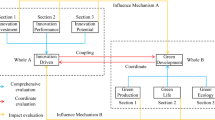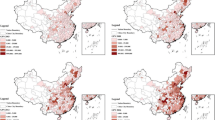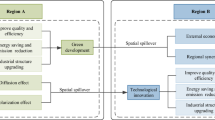Abstract
The improvement of green innovation efficiency (GIE) in the Yangtze river economic belt (YREB) is beneficial to China’s green transformation and upgrading because of its economic and ecological position. Therefore, based on the slacks-based measure of super-efficiency (Super-SBM) model, the paper studies the GIE and its spatial-temporal variation characteristics in the YREB during the period 2003–2015, and analyzes the spatial correlation and spatial-temporal convergence of GIE with the exploratory spatial data analysis (ESDA) method and convergence analysis method. The results show that the GIE in the YREB shows an “U-shaped” change pattern in time and an extremely unbalanced development pattern in space. The areas with high GIE contribute to the improvement of overall GIE, whereas they do not exert a radiation and driving effect on areas with low GIE. Accordingly, because of the short board effect, the convergent speed of the GIE is decreasing. To be specific, the GIE keeps converging in the upper and lower reaches, except for the year 2010 when GIE in the middle reaches changed from being convergent to being non-convergent. Even though environmental policy exerts great impacts on the improvement of GIE, the lack of collaborative environmental governance leads to the non-convergent and unbalanced development of the GIE. Therefore, green coordinated development of the YREB is necessary.






Similar content being viewed by others
Notes
Data resource from China Statistical Yearbook (2017).
Nine provinces are Zhejiang, Jiangsu, Anhui, Hubei, Jiangxi, Hunan, Sichuan, Yunnan, and Guizhou and two municipalities are Shanghai and Chongqing.
The Yangtze River Basin can be divided into areas of upper reaches (Chongqing, Sichuan, Guizhou, Yunnan), middle reaches (Jiangxi, Hubei, Hunan), and lower reaches (Shanghai, Jiangsu, Zhejiang, Anhui).
Data resource from local government websites of the YREB.
GIE mean value (A), GIE mean value plus half A standard deviation (B), and GIE mean value half A standard deviation (C), four categories are classified according to GIEI≥B, A ≤ GIE < B, C ≤ GIE < A and GIE < C.
References
Albort-Morant G, Leal-Millan A, Cepeda-Carrion G (2016) The antecedents of green innovation performance: a model of learning and capabilities. J Bus Res 69(11SI):4912–4917. https://doi.org/10.1016/j.jbusres.2016.04.052
Anselin L (1995) Local indicators of spatial association--LISA. Geogr Anal 27(2):93–115. https://doi.org/10.1111/j.1538-4632.1995.tb00338.x
Cai H, Chen Y, Gong Q (2016) Polluting thy neighbor: unintended consequences of China’s pollution reduction mandates. J Environ Econ Manag 76:86–104. https://doi.org/10.1016/j.jeem.2015.01.002
Cheng Y, Yin Q (2016) Study on the regional difference of green innovation efficiency in China: an empirical analysis based on the panel data. Atlantis Press, Paris, pp 893–900. https://doi.org/10.2991/978-94-6239-145-1_86
Du J, Liang L, Zhu J (2010) A slacks-based measure of super-efficiency in data envelopment analysis: a comment. Eur J Oper Res 204(3):694–697. https://doi.org/10.1016/j.ejor.2009.12.007
Feng Z (2013) Research on green innovation efficiency of industrial enterprises in China. Forum on Science and Technology in China 2:82–88
Guan J, Chen K (2010) Measuring the innovation production process: a cross-region empirical study of China’s high-tech innovations. Technovation 30(5–6):348–358. https://doi.org/10.1016/j.technovation.2010.02.001
Guo P, Zhou X, Li D, Wang T (2013) Dilemma and solution of coal resource-based economic transition: analysis from the perspective of energy technology innovation. China Soft Sci 7:39–46
Jin G, Shen K (2018) Beggar-thy-neighbour or neighbours?: environmental regulation enforcement interaction and urban productivity growth. Manag World 34(12):43–55
Jin W, Zhang H, Liu S, Zhang H (2019) Technological innovation, environmental regulation, and green total factor efficiency of industrial water resources. J Clean Prod 211:61–69. https://doi.org/10.1016/j.jclepro.2018.11.172
Li X, He N (2018) Study on the impact of environmental tax on enterprise’s green technology innovation under regional competition. China Popu Resour Environ 28(9):73–81
Liu G (2015) Evaluating the regional green innovation efficiency in China: a DEA-malmquist productivity index approach. Appl Mech Mater 733:355–362. https://doi.org/10.4028/www.scientific.net/amm.733.355
Liu H, Wang Q, Song Y, Li G, Li L (2008) Research on regional circular economy based on emergy analysis: a case study of Liaoning province. Resour Sci 2:192–198
Liu Q, Wang Q, Li P (2012) Pollution-intensive industries in China and the variation trend of their regional distribution. Ecol Econ (Chinese Version) 1:107–112
Lu L, Song D, Li X (2016) Study on the green efficiency of urban development in Yangtze River Economic Belt. China Popul Resour Environ 26(6):35–42
Lund H, Hvelplund F (2012) The economic crisis and sustainable development: the design of job creation strategies by use of concrete institutional economics. Energy 43(1):192–200. https://doi.org/10.1016/j.energy.2012.02.075
Luo L, Liang S (2016) En technological innovation efficiency and factor decomposition of regional industrial enterprises in China. China Popul Resour Environ 26(9):149–157
Niu T, Peng S, Niu C, Chen X, Du B (2015) Research on green innovation efficiency of industrial enterprises in Shanxi province based on SBM-DEA four-stage method. Sci Technol Manag Res 35(10):244–249
Ren Y, Niu C, Niu T, Yao X (2014) Theoretical model and empirical research on green innovation efficiency. Manag World 7:176–177
Rincon Ruiz A, Pascual U, Romero M (2013) An exploratory spatial analysis of illegal coca cultivation in Colombia using local indicators of spatial association and socioecological variables. Ecol Indic 34:103–112. https://doi.org/10.1016/j.ecolind.2013.04.008
Song S, Fan X (2017) Impact of bilateral environmental regulations on interregional transfer of pollution industries in China. Econ Survey 34(2):99–104
Sueyoshi T, Goto M (2011) DEA approach for unified efficiency measurement: assessment of Japanese fossil fuel power generation. Energy Econ 33(2):292–303. https://doi.org/10.1016/j.eneco.2010.07.008
Tang K, Qiu Y, Zhou D (2020) Does command-and-control regulation promote green innovation performance? Evidence from China’s industrial enterprises. Sci Total Environ 712:136362. https://doi.org/10.1016/j.scitotenv.2019.136362
Tobler WR (1970) A computer movie simulating urban growth in the Detroit region. Econ Geogr 46:234–240. https://doi.org/10.2307/143141
Tone K (2001) A slacks-based measure of efficiency in data envelopment analysis. Eur J Oper Res 130(3):498–509. https://doi.org/10.1016/S0377-2217(99)00407-5
Tone K (2002) A slacks-based measure of super-efficiency in data envelopment analysis. Eur J Oper Res 143(PII S0377-2217(01)00324-11):32–41. https://doi.org/10.1016/S0377-2217(01)00324-1
Tone K, Tsutsui M (2009) Network DEA: a slacks-based measure approach. Eur J Oper Res 197(1):243–252. https://doi.org/10.1016/j.ejor.2008.05.027
Wang P, Xie L (2014) Investment in pollution control, enterprise technological innovation and pollution control efficiency. China Popul Resour Environ 24(9):51–58
Wang H, Miao Z, Wang S (2015) Spatial spillover, industrial agglomeration effect and industrial green innovation efficiency. Forum on Science and Technology in China 12:33–38
Wang W, Yu B, Yan X, Yao X, Liu Y (2017) Estimation of innovation’s green performance: a range-adjusted measure approach to assess the unified efficiency of China’s manufacturing industry. J Clean Prod 149:919–924. https://doi.org/10.1016/j.jclepro.2017.02.174
Wu Y (2006) R&D and productivity: empirical study based on China’s manufacturing industry. Econ Res J 11:60–71
Xu X, Yang G, Tan Y (2019) Identifying ecological red lines in China’s Yangtze River Economic Belt: a regional approach. Ecol Indic 96(1):635–646. https://doi.org/10.1016/j.ecolind.2018.09.052
Yang S, Wu T, Li Z (2018) Study on the spatial-temporal differentiation and impacting factors of green innovation efficiency in Yangtze River Economic Belt. Macroeconomics 6:107–117
Yi M, Cheng X (2018) Spatial-temporal distribution of urban green innovation efficiency and its influencing factors in the Yangtze River Economic Belt. Urban Probl 8:31–39
Zhang Y, Lin X (2015) Research on double evolution of interprovincial green innovation efficiency and system coordination degree in China. Contemp Econ Res 3:51–56
Zhang Y, Wang J, Xue Y, Yang J (2018) Impact of environmental regulations on green technological innovative behavior: an empirical study in China. J Clean Prod 188:763–773. https://doi.org/10.1016/j.jclepro.2018.04.013
Zhu J (1998) Data envelopment analysis vs. principal component analysis: an illustrative study of economic performance of Chinese cities. Eur J Oper Res 111(1):50–61. https://doi.org/10.1016/S0377-2217(97)00321-4
Zhu P, Xu W (2003) Impact of government's science and technology incentive policy on R&D input and patent output of large and medium-sized industrial enterprises: empirical study of Shanghai. Econ Res J 06:45–53
Zhu Y, Yang L, Lv H, Shen X (2012) Study on the effects of resource shortage, environmental damage and industrial agglomeration: based on the empirical analysis of China’s provincial industrial agglomeration in the 21st century. Manag World 11:28–44
Funding
This research was jointly supported by the Humanities and Social Sciences Planned Foundation from Ministry of Education of China (Grant No.19YJA630103) and the Fundamental Research Funds for the Central Universities, China University of Geosciences (Wuhan) (Grant No.CUGQY1942) and Hubei province regional innovation ability monitoring and analysis soft science research base open fund project (Grant No.HBQY2018z11).
Author information
Authors and Affiliations
Corresponding author
Additional information
Responsible editor: Eyup Dogan
Publisher’s note
Springer Nature remains neutral with regard to jurisdictional claims in published maps and institutional affiliations.
Rights and permissions
About this article
Cite this article
Xu, S., Wu, T. & Zhang, Y. The spatial-temporal variation and convergence of green innovation efficiency in the Yangtze River Economic Belt in China. Environ Sci Pollut Res 27, 26868–26881 (2020). https://doi.org/10.1007/s11356-020-08865-3
Received:
Accepted:
Published:
Issue Date:
DOI: https://doi.org/10.1007/s11356-020-08865-3




